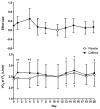Time Course and Magnitude of Tolerance to the Ergogenic Effect of Caffeine on the Second Ventilatory Threshold
- PMID: 33321978
- PMCID: PMC7764462
- DOI: 10.3390/life10120343
Time Course and Magnitude of Tolerance to the Ergogenic Effect of Caffeine on the Second Ventilatory Threshold
Abstract
Pre-exercise caffeine ingestion has been shown to increase the workload at ventilatory threshold, suggesting an ergogenic effect of this stimulant on submaximal aerobic exercise. However, the time course of tolerance to the effect of caffeine on ventilatory threshold is unknown. This study aimed to determine the evolution of tolerance to the ergogenic effect of caffeine on the ventilatory threshold.
Methods: Eleven participants (age 32.3 ± 4.9 yrs, height 171 ± 8 cm, body mass 66.6 ± 13.6 kg, VO2max = 48.0 ± 3.8 mL/kg/min) took part in a longitudinal, double-blind, placebo-controlled, randomized, crossover experimental design. Each participant took part in two identical treatments: in one treatment, participants ingested a capsule containing 3 mg of caffeine per kg of body mass per day (mg/kg/day) for twenty consecutive days; in the other treatment, participants ingested a capsule filled with a placebo for the same duration and frequency. During these treatments, participants performed a maximal ramp test on a cycle ergometer three times per week and the second ventilatory threshold (VT2) was assessed by using the ventilatory equivalents for oxygen and carbon dioxide.
Results: A two-way ANOVA with repeated measures (substance × time) revealed statistically significant main effects of caffeine (p < 0.01) and time (p = 0.04) on the wattage obtained at VT2, although there was no interaction (p = 0.09). In comparison to the placebo, caffeine increased the workload at VT2 on days 1, 4, 6 and 15 of ingestion (p < 0.05). The size of the ergogenic effect of caffeine over the placebo on the workload at VT2 was progressively reduced with the duration of the treatment. In addition, there were main effects of caffeine (p = 0.03) and time (p = 0.16) on VO2 obtained at VT2, with no interaction (p = 0.49). Specifically, caffeine increased oxygen uptake at VT2 on days 1 and 4 (p < 0.05), with no other caffeine-placebo differences afterwards. For heart rate obtained at VT2, there was a main effect of substance (p < 0.01), while the overall effect of time (p = 0.13) and the interaction (p = 0.22) did not reach statistical significance. Heart rate at VT2 was higher with caffeine than with the placebo on days 1 and 4 (p < 0.05). The size of the effect of caffeine on VO2 and heart at VT2 tended to decline over time.
Conclusion: Pre-exercise intake of 3 mg/kg/day of caffeine for twenty days enhanced the wattage obtained at VT2 during cycling ramp tests for ~15 days of ingestion, while there was a progressive attenuation of the size of the ergogenic effect of caffeine on this performance variable. Therefore, habituation to caffeine through daily ingestion may reduce the ergogenic effect of this stimulant on aerobic exercise of submaximal intensity.
Keywords: endurance athlete; endurance performance; exercise performance; nutrition; sport performance.
Conflict of interest statement
The authors declare no conflict of interest.
Figures



Similar articles
-
Time course of tolerance to the performance benefits of caffeine.PLoS One. 2019 Jan 23;14(1):e0210275. doi: 10.1371/journal.pone.0210275. eCollection 2019. PLoS One. 2019. PMID: 30673725 Free PMC article. Clinical Trial.
-
Acute caffeine intake increases muscle oxygen saturation during a maximal incremental exercise test.Br J Clin Pharmacol. 2020 May;86(5):861-867. doi: 10.1111/bcp.14189. Epub 2020 Jan 14. Br J Clin Pharmacol. 2020. PMID: 31782534 Free PMC article. Clinical Trial.
-
Ergogenic effects of caffeine on peak aerobic cycling power during the menstrual cycle.Eur J Nutr. 2020 Sep;59(6):2525-2534. doi: 10.1007/s00394-019-02100-7. Epub 2019 Nov 5. Eur J Nutr. 2020. PMID: 31691019 Clinical Trial.
-
Ergogenic Effects of Acute Caffeine Intake on Muscular Endurance and Muscular Strength in Women: A Meta-Analysis.Int J Environ Res Public Health. 2021 May 27;18(11):5773. doi: 10.3390/ijerph18115773. Int J Environ Res Public Health. 2021. PMID: 34072182 Free PMC article. Review.
-
Effect of Acute Caffeine Intake on the Fat Oxidation Rate during Exercise: A Systematic Review and Meta-Analysis.Nutrients. 2020 Nov 24;12(12):3603. doi: 10.3390/nu12123603. Nutrients. 2020. PMID: 33255240 Free PMC article.
Cited by
-
Caffeine and Sports Performance: The Conflict between Caffeine Intake to Enhance Performance and Avoiding Caffeine to Ensure Sleep Quality.Sports Med. 2025 Jul;55(7):1579-1592. doi: 10.1007/s40279-025-02245-y. Epub 2025 Jun 27. Sports Med. 2025. PMID: 40579619 Free PMC article. Review.
-
The effect of repeated coffee mouth rinsing and caffeinated gum consumption on aerobic capacity and explosive power of table tennis players: a randomized, double-blind, placebo-controlled, crossover study.J Int Soc Sports Nutr. 2024 Dec;21(1):2340556. doi: 10.1080/15502783.2024.2340556. Epub 2024 Apr 11. J Int Soc Sports Nutr. 2024. PMID: 39663645 Free PMC article. Clinical Trial.
-
Acute Effects of High Doses of Caffeine on Bar Velocity during the Bench Press Throw in Athletes Habituated to Caffeine: A Randomized, Double-Blind and Crossover Study.J Clin Med. 2021 Sep 25;10(19):4380. doi: 10.3390/jcm10194380. J Clin Med. 2021. PMID: 34640398 Free PMC article.
-
Low-Dose Caffeine Supplementation Is a Valuable Strategy for Increasing Time to Exhaustion, Explosive Power, and Reducing Muscle Soreness in Professional Male Kickboxers.Curr Dev Nutr. 2024 Dec 21;9(1):104538. doi: 10.1016/j.cdnut.2024.104538. eCollection 2025 Jan. Curr Dev Nutr. 2024. PMID: 39886079 Free PMC article.
-
Effect of Acute Caffeine Intake on Fat Oxidation Rate during Fed-State Exercise: A Systematic Review and Meta-Analysis.Nutrients. 2024 Jan 8;16(2):207. doi: 10.3390/nu16020207. Nutrients. 2024. PMID: 38257100 Free PMC article.
References
LinkOut - more resources
Full Text Sources

